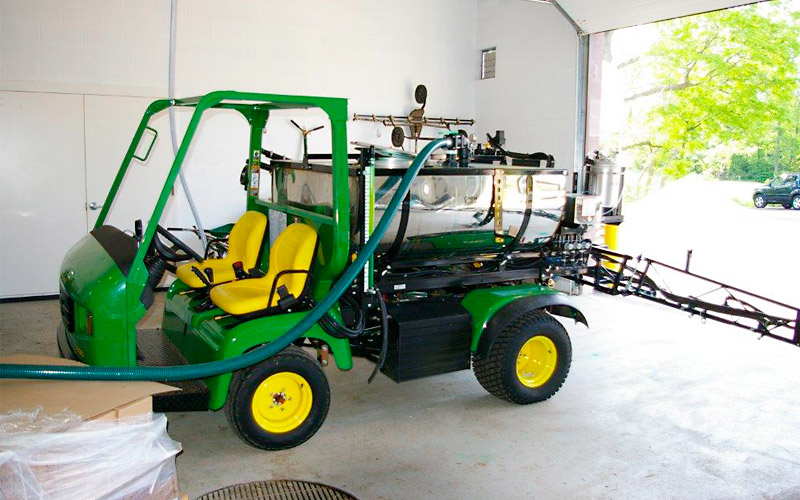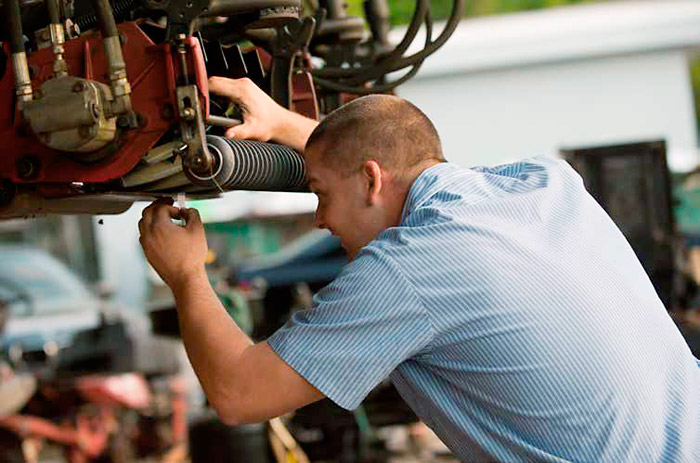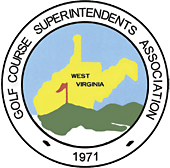Maintenance Operations

Equipment maintenance, fueling, and chemical storage can have an impact on water quality on-site and off-site both during construction and during the maintenance of existing golf courses.
Regulatory Considerations
Local and state regulations may be in place in your location. Early engagement among developers, designers, local community groups and permitting agencies is essential to designing and constructing a golf maintenance and storage facility that minimizes environmental impact and meets the needs for the approval process.
Storage and Handling of Chemicals
Principles
- Proper handling and storage of pesticides and petroleum-based products is important to reduce risk of serious injury or death of an operator or bystander. Fires or environmental contamination may result in large fines, cleanup costs, and civil lawsuits if these chemicals are not managed properly.
- Check federal, state, and local regulations for specific requirements related to storage of pesticides.
Best Management Practices
- Storage buildings should have appropriate warning signs and placards.
- Follow all personal protective equipment (PPE) statements on pesticide labels.
- Store PPE away from pesticide storage areas in an area that is easily accessible.
- Develop an emergency response plan and educate all golf course personnel regarding emergency procedures on a regular basis.
- Individuals conducting emergency chemical cleanups should be properly trained under requirements of federal Occupational Safety and Health Administration (OSHA).
- Store pesticides in a lockable concrete or metal building.
- Locate pesticide storage away from other buildings, especially fertilizer storage facilities.
- Floors of chemical storage buildings should be impervious and sealed with chemical-resistant paint.
- Floors of chemical storage buildings should have a continuous sill to contain spills and should not have a drain. A sump is acceptable.
- Shelving should be fabricated from plastic or reinforced metal. Metal shelving should be painted to avoid corrosion. Wood shelving should never be used because of its ability to absorb spilled pesticides.
- Automatic exhaust fans and an emergency wash area should be provided
- Explosion-proof lighting may be required. Locate fan and light switches outside the entrance to the building to facilitate ventilation of building before entrance of staff.
- Maintain detailed records of current pesticide inventory in the storage facility. Safety Data Sheets (SDS) for the chemicals stored on-site should be stored separate from the storage room, but readily accessible on-site.
- Do not store large quantities of pesticides or chemicals for long periods of time. Follow a “first in, first out” principle to rotate products into use to ensure products do not expire.
- Store chemicals in original containers. Never store them in containers that might be mistaken as packaging for food or drink.
- Arrange containers so the labels are clearly visible. Securely fasten loose labels to ensure containers and associated labels are kept together.
- Damaged labels should be replaced immediately.
- Store flammable pesticides separate from those that are nonflammable.
- Store liquid materials below dry materials to prevent leaks from contaminating dry products.
- Ensure that oil containers and small fuel containers (service containers) are properly labeled and stored within the facility.
Equipment Storage and Maintenance
Principle
Storing and maintaining equipment properly will extend useful life and reduce repairs.
Best Management Practices
- Store and maintain equipment in a covered area complete with a sealed impervious surface to limit risk of fluid leaks contaminating the environment and to facilitate the early detection of small leaks that may require repair before causing significant damage to the turf or the environment.
- Seal floor drains unless they are connected to a holding tank or sanitary sewer with permission from the local wastewater treatment plant.
- Store pesticide and fertilizer application equipment in areas protected from rainfall. Rain can wash pesticide and fertilizer residues from the exterior of the equipment and possibly contaminate soil or water.
- Store solvents and degreasers in lockable metal cabinets away from ignition sources in a well-ventilated area. These products are generally toxic and highly flammable. Never store them with fertilizers or in areas where smoking is permitted.
- Keep an inventory of solvents and SDS for those materials on-site but in a different location where they will be easily accessible in case of an emergency.
- Keep basins of solvent baths covered to reduce emissions of volatile organic compounds (VOC).
- When possible, replace solvent baths with recirculating aqueous washing units. Soap and water or other aqueous cleaners are often as effective as solvent-based products and present a lower risk to the environment.
- Always use appropriate PPE when working with solvents.
- Never allow solvents or degreasers to drain onto pavement or soil, or discharge into waterbodies, wetlands, storm drains, sewers, or septic systems.
- Collect used solvents and degreasers in containers clearly marked with contents and date; schedule collection by a commercial service.
- Blow off all equipment with compressed air to reduce damage to hydraulic seals.
Waste Handling
Principles
- Proper disposal of waste materials is critical for protection of water and natural resources. State or local laws and regulations related to disposal of hazardous waste products may vary. Be sure to familiarize yourself with all state and local laws related to disposal/recycling of these waste materials.
- Identify and implement waste-reduction practices.
- Look for ways to increase recycling efforts and programs.
- Purchase environmentally preferred products in bulk packaging when possible.
Best Management Practices
- Pesticides that have been mixed for application must be disposed of as waste and may be classified as hazardous waste depending on the materials involved. Contact local authorities for guidance regarding proper disposal.
- Collect used oil, oil filters, and antifreeze in separate marked containers and recycle them as directed by local and state authorities.
- Antifreeze may be considered hazardous waste by state or local laws and should be handled accordingly. Commercial services are available to collect and recycle antifreeze.
- Lead-acid batteries are classified as hazardous waste unless they are properly recycled.
- Store old batteries on impervious services where they are protected from rainfall and recycle as soon as possible.
- Recycle used tires.
- Recycle or dispose of fluorescent tubes and other lights according to state requirements.
Equipment Washing
Principle
Wash water generated from equipment-washing facilities can be a source of both surface-water and groundwater pollution. Steps should be taken to prevent pollution.
Best Management Practices
- Equipment washing areas should drain to an oil/water separator before draining to a sanitary sewer or holding tank.
- Consider the use of a closed-loop wash-water recycling system.
- Grass-covered equipment should be brushed or blown off with compressed air before being washed.
- Wash equipment with a bucket of water and a rag to minimize the amount of water used and use only the minimal amount of water required to rinse the machine.
- Spring-operated shut-off nozzles should be used.
- Do not allow any wastewater to flow directly into surface waters or storm drains.
Fueling Facilities
Principle
Safe storage of fuel, including use of above-ground tanks and containment facilities, is critical to the protection of the environment. State or local laws and regulations related to storage of fuel may vary.
Best Management Practices
- Locate fueling facilities on roofed areas with a concrete (not asphalt) pavement. Areas should be equipped with spill-containment and recovery facilities.
- Use of above ground fuel tanks is preferred.
Pollution Prevention
Principles
- Plan appropriately to minimize the possibility of an elicit discharge and need for disposal. Monitor the water to be discharged for contamination; never discharge to the environment any contaminated water. If the water is not contaminated, it can be reused or discharged to a permitted stormwater treatment system.
- Pesticide leaks or spills, if contained, will not percolate down through the soil into groundwater or run off the surface to contaminate streams, ditches, ponds, and other water bodies.
- Wash water from pesticide application equipment must be managed properly, since it contains pesticide residues. This applies to wash water from both the inside and the outside of the application equipment. Material should be collected and used as a pesticide in accordance with the label instructions for that pesticide.
- An equipment-washing facility can be a source of both surface water and groundwater pollution, if the wash water generated is not properly handled. All equipment used in the maintenance of golf courses and associated developments should be designed, used, maintained, and stored in a way that eliminates or minimizes the potential for pollution.
- One of the key principles of pollution prevention is to reduce the unnecessary use of potential pollutants. Over time, the routine discharge of even small amounts of solvents can result in serious environmental and liability consequences, because of the accumulation of contaminants in soil or groundwater.
- The proper handling and storage of pesticides is important. Failure to do so correctly may lead to the serious injury or death of an operator or bystander, fires, environmental contamination that may result in large fines and cleanup costs, civil lawsuits, the destruction of the turf you are trying to protect, and wasted pesticide product.
- Generating as little as 25 gallons per month of used solvents for disposal can qualify you as a “small-quantity generator” of hazardous waste, triggering EPA and state reporting requirements.
- Pesticides that have been mixed so they cannot be legally applied to a site in accordance with the label must be disposed of as a waste. Depending on the materials involved, they may be classified as hazardous waste.
- Provide adequate protection from the weather. Rain can wash pesticide and fertilizer residues from the exterior of the equipment, and these residues can contaminate soil or water.
- Never allow solvents to drain onto pavement or soil, or discharge into water bodies, wetlands, storm drains, sewers, or septic systems, even in small amounts.
- Office paper, recyclable plastics, glass, and aluminum should be recycled. Place containers for recycling aluminum cans and glass or plastic soft drink bottles at convenient locations on the golf course.
Best Management Practices
- Pesticides should be stored in a lockable concrete or metal building.
- Pesticide storage and mixing facility floors should be impervious and sealed with a chemical-resistant paint. Floors should have a continuous sill to retain spilled materials and no drains, although a sump may be included.
- For valuable information about constructing chemical mixing facilities, reference the Midwest Plan Service book, Designing Facilities for Pesticide and Fertilizer Containment (revised 1995); the Tennessee Valley Authority (TVA) publication, Coating Concrete Secondary Containment Structures Exposed to Agrichemicals (Broder and Nguyen, 1995); and USDA–NRCS Code 703.
- Use a chemical mixing center (CMC) as a place for performing all operations where pesticides are likely to be spilled in concentrated form—or where even dilute formulations may be repeatedly spilled in the same area—over an impermeable surface. (A CMC is a concrete pad treated with a sealant and sloped to a liquid-tight sump where all of the spilled liquids can be recovered.)
- Flush wash pad with clean water after the equipment is washed. Captured wash water can be used as a dilute pesticide per labeled site, or it may be pumped into a rinsate storage tank for use in the next application.
- FIFRA, Section 2(ee), allows the applicator to apply a pesticide at less than the labeled rate.
- The sump should then be cleaned of any sediment before another type of pesticide is handled.
- Discharge to a treatment system that is permitted under industrial wastewater rules.
- Never discharge to a sanitary sewer system without written permission from the utility.
- Never discharge to a septic tank.
- Use a closed-loop wash-water recycling system and follow appropriate BMP.
- Use non-containment wash water for field irrigation.
- Do not discharge non-contaminated wastewater during or immediately after a rainstorm, since the added flow may cause the permitted storage volume of the stormwater system to be exceeded.
- Whenever practical, replace solvent baths with recirculating aqueous washing units (which resemble heavy-duty dishwashers).
- Use soap and water or other aqueous cleaners; these products are often as effective as solvent-based ones.
- Blowing off equipment with compressed air instead of washing with water is often easier on hydraulic seals and can lead to fewer oil leaks.
- Grass-covered equipment should be brushed or blown with compressed air before being washed. Dry material is much easier to handle and store or dispose of than wet clippings.
- It is best to wash equipment with a bucket of water and a rag, using only a minimal amount of water to rinse the machine.
- Clean up spills as soon as possible.
- Keep spill cleanup equipment available when handling pesticides or their containers.
- If a spill occurs of a pesticide covered by certain state and federal laws, you may need to report any accidental release if the spill quantity exceeds the “reportable quantity” of active ingredient specified in the law.
- Large spills or uncontained spills involving hazardous materials may best be remediated by hazardous material cleanup professionals.
- For emergency (only) information on hazards or actions to take in the event of a spill, call CHEMTREC, at (800)424–9300. CHEMTREC is a service of the Chemical Manufacturers Association. For information on whether a spilled chemical requires reporting, call the CERCLA/RCRA help line at (800) 424–9346.
- Do not allow any wash water to flow directly into surface waters or storm drains.
- Avoid washing equipment in the vicinity of wells or surface water bodies.
- Wash equipment over a concrete or asphalt pad that allows the water to be collected. After the residue dries on the pad, collect, compost, or spread in the field.
- If applicable, allow runoff onto a grassed area to soak into the ground, but never into a surface water body or canal.
- Use compressed air to blow off equipment. This is less harmful to the equipment’s hydraulic seals, eliminates wastewater, and produces dry material that is easier to handle.
- Handle clippings and dust separately. After the residue dries on the pad, it can be collected and composted or spread in the field.
- Minimize the use of detergents. Use only biodegradable non-phosphate detergents.
- Minimize the amount of water used to clean equipment. This can be done by using spray nozzles that generate high-pressure streams of water at low volumes.
- Do not discharge wash water to surface water or groundwater either directly or indirectly through ditches, storm drains, or canals.
- Do not conduct equipment wash operations on a pesticide mixing and loading pad. (This keeps grass clippings and other debris from becoming contaminated with pesticide).
- Solvents and degreasers should be used over a collection basin or pad that collects all used material.
- Oil/water separators can be used but must be managed properly to avoid problems. Do not wash equipment used to apply pesticides on pads with oil/water separators
- Collect used solvents and degreasers, place them into containers marked with the contents and the date, and then have them picked up by a service tha properly recycles or disposes of them. Never mix used oil or other liquid material with the used solvents.
- Collect used oil, oil filters, and antifreeze in separate marked containers and recycle them. Arrange pickup of used oil, or deliver to a hazardous waste collection site.
- Do not mix used oil with used antifreeze or sludge from used solvents. Antifreeze must be recycled or disposed of as a hazardous waste.
- Store batteries on an impervious surface and preferably under cover. Remember, spent lead-acid batteries must be recycled if they are to be exempt from strict hazardous waste regulations.
- Lead-acid storage batteries are classified as hazardous wastes unless they are recycled. All lead-acid battery retailers in Florida are required by law to accept returned batteries for recycling.
- Spent lead-acid batteries must be recycled if they are to be exempt from strict hazardous waste regulations.
- Equipment used to apply pesticides and fertilizers should be stored in areas protected from rainfall.
- Pesticide application equipment can be stored in the chemical mixing center (CMC), but fertilizer application equipment should be stored separately.
- Blow or wash loose debris off equipment to prevent dirt from getting on the CMC pad, where it could become contaminated with pesticides.
- Ensure that all containers are sealed, secured, and properly labeled. Use only regulatory agency-approved, licensed contractors for disposal.
- Rinse pesticide containers as soon as they are empty. Pressure rinse or triple-rinse containers, and add the rinse water to the sprayer.
- Shake or tap non-rinseable containers, such as bags or boxes, so that all dust and material fall into the application equipment.
- After cleaning them, puncture the pesticide containers to prevent reuse (except glass and refillable mini-bulk containers).
- Keep the rinsed containers in a clean area, out of the weather, for disposal or recycling.
- Storing the containers in large plastic bags/tubs to protect the containers from collecting rainwater.
- Recycle rinsed containers in counties where an applicable program is available, or take them to a landfill for disposal. Check with your local landfill before taking containers for disposal, as not all landfills will accept them.





